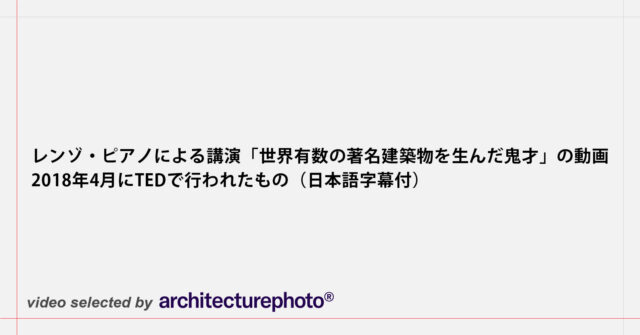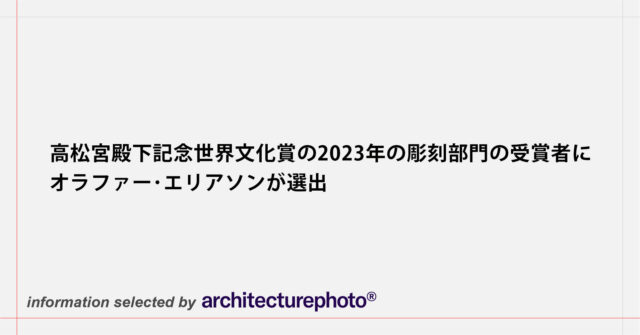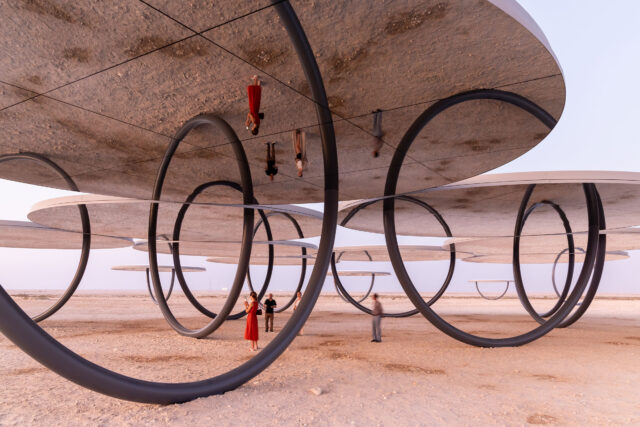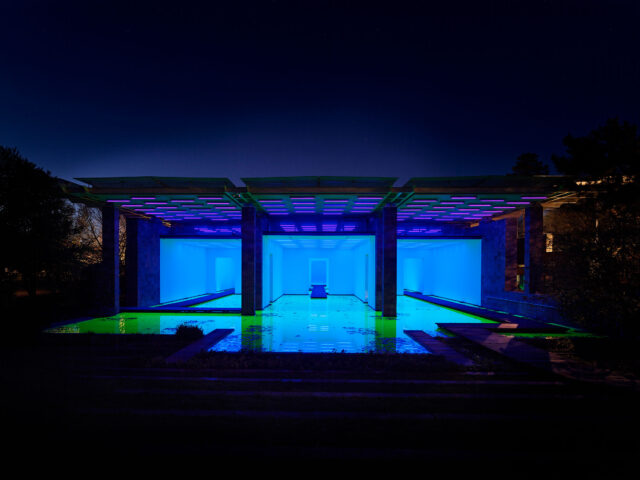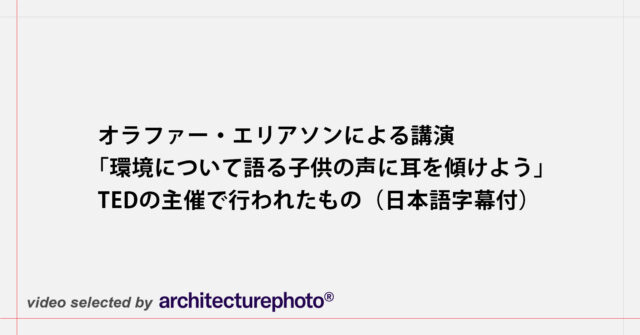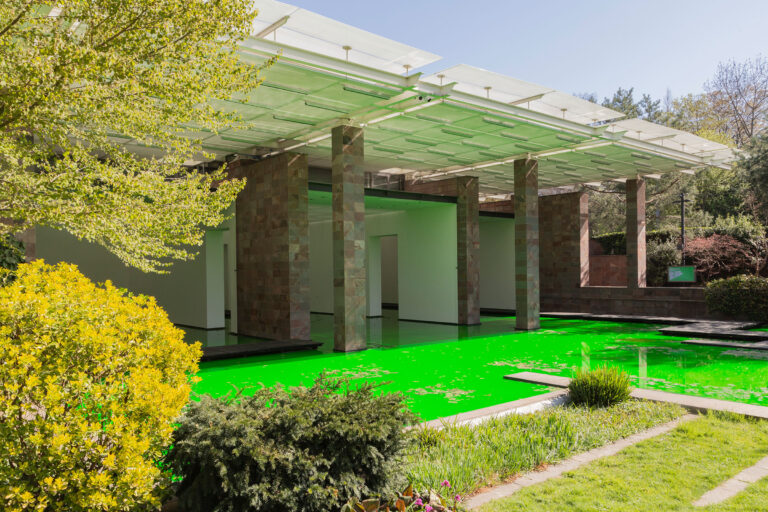
SHARE オラファー・エリアソンによる、バイエラー財団での展覧会「LIFE」の会場写真。レンゾ・ピアノ設計の美術館のガラスを取り除き内外を繋く作品を発表




アーティストのオラファー・エリアソンによる、バイエラー財団での展覧会「LIFE」の会場写真です。レンゾ・ピアノが設計して1997に完成したスイス・バーゼルの美術館のガラスを取り除き内外を繋く作品を発表しています。会期は2021年7月まで(詳細な日程は決まっていないようです)。展覧会の公式サイトはこちらで、特殊なライブカメラで会場の様子も閲覧できます。
こちらは、アーティストによるステートメントを抜粋して翻訳したものです
ここ数年、生命を人間中心の視点ではなく、広く生物中心の視点で考える取り組みに興味を持つようになりました。展覧会を見ていると、名詞を動詞に変えたり、人間がきちんと想像できる範囲を超えた視点に気づくために、例えば、「to tree」にしてみたりしています。想像してみてください。
人間の生命は、他の哺乳類と同様に、吸って吐いて、酸素に依存しています。人類学者のナターシャ・マイヤーズやティモシー・チョイの言葉を借りれば、人生とは「共謀すること」でもあると言えます。私たちは、木と、人と、そして地球と共謀しています。
私たちの生活は、周囲の環境や、ローカルなコンテクストをはるかに超えた構造やシステムと密接に絡み合っていることを認識すると、私たちは誰もが脆弱であり、完全にコントロールできるわけではないということを学ぶのではないでしょうか。私たちは、不確実で結果がはっきりしない状況の中で行動し、交流しています。
人類学者のアンナ・L・ツェンの言葉です。
「かつては、災難は恵まれない人の運命のように思われていました。今では、私たちの生活は、たとえ今のところポケットの中が潤っていても、すべて不安定であるように思えます。」
私の作品「ライフ」、そしてバイエラー財団は、周囲の公園や都市の景観、そして地球と絡み合っており、そこで出会うすべてのものや人々を通して命を吹き込まれています。
私は1990年代初頭にアーティストとして活動を始めて以来、知覚とそれを形成する認知的・文化的条件に興味を持ってきました。「ライフ」は、あなたが能動的に出会うことで、あなたの知覚を通して生きてくるのです。来場者がこの展覧会に対する認識や理解を形成する可能性があるため、作品には教訓的なテキストや説明的なテキストを添えないことにしました。「ライフ」に対する限定される視点を共有しないことは、私にとって重要なことなのです。作品の制作とその継続についての私の考えや、作品のインスピレーションの源については、ここで見つけられるでしょう。同時に、来場者が作品に期待や記憶、考えや感情を持ち込んでくれることを歓迎します。
「ライフ」は、未来の風景のモデルを提示します。それはホスピタリティです。数年前、バイエラー財団のディレクターであるサム・ケラー氏と私が初めて展覧会について話し合ったとき、私は「みんなを展覧会に招待しよう」と考えました。惑星の植物やさまざまな種を招待しよう。単にドアを開けるだけではなく、施設から外部を遮断する構造的な境界線を取り除くことにしました。バイエラー財団と、美術館を建設した建築家のレンゾ・ピアノに感謝しています。私を信頼して、慎重かつ思いやりを持って、建物からガラスのファサードを取り除いてもらいました。
私は美術館とともに、いわば作品の管理を放棄し、人間や非人間の訪問者、植物、微生物、天候、気候など、通常の美術館が懸命に排除しようとしているさまざまな要素に作品を委ねているのです。そうではなく、すべての人、すべてのものを迎え入れようとしているのです。
私が興味を持っているのは、私たちが感覚をどのように使うか、意識をどのように使うかということです。そして、無感覚になったらどうなるのか。私の友人である認知科学者で詩人のPireeni Sundaralingam氏は、デジタル環境が神経学的ストレスや脅威に基づく行動パターンを構築する注意捕獲システムとして構築されることが多いという研究を行っています。彼女は、豊かな感覚を持つ環境や、脅威ではなく不確実性を受け入れるデジタルまたは物理的な空間は、成長、創造性、革新、回復力などの脳の発達の面でプラスの影響を与えると主張しています。私は、「Life」が来場者に、より大きく手に負えない生態系に巻き込まれた複合的な存在として、拡大したオープンで不確実な風景の中で自分自身を体験することを促すことを願っています。
「ライフ」は、人間の来場者に、その全感覚を活性化する機会を提供します。植物や水の匂い、周囲の音、空気中の水分などを通して、観客は常に視覚だけではなく、作品を探索するように誘われます。それは、風景の中での「パノラマ的な認識」を促すものです。自分の後ろ、左右、上にあるものは、自分の前と前にあるものと同じくらい重要であることを示唆しています。私は最近、人類学者でダンサーのナターシャ・マイヤーズを知るようになりました。彼女は、植物と人間の関係の可能性を把握するために、彼女が言うところの「ベジタライズ」を私たちの感覚に求めています。エッセイの中でマイヤーズはこう問いかけています。植物は何を求めているのか?植物は何を知っているのか?植物には何ができるのか?私たちはまだ知りません。しかし、知らないという開放感を持って、知識だと思っていたことを忘れて、彼らに向かって手を伸ばすことができる。
以下の写真はクリックで拡大します






















こちらでは会場の動画も見ることができます。
以下、アーティストによるステートメントの全文です。
OLAFUR ELIASSON ON LIFE AT THE FONDATION BEYELER
In recent years, I have increasingly grown interested in efforts to consider life not from a human centric perspective but from a broad, biocentric perspective. I’ve found myself turning nouns into verbs when I go through my exhibition, I try to tree, for instance in order to become aware of perspectives that go beyond what we humans can properly imagine.
Life for humans, like all mammals, depends on inhaling and exhaling, on oxygen. Following the anthropologists Natasha Myers and Timothy Choy, I’d say that life is also about con spiring playing on the origin of the word (‘to breathe with’) as well as the dictionary definition. We conspire with the tree, with others, and with the planet.
When we recognise that our lives are inextricably entangled with our surroundings and with structures and systems that extend far beyond our local context, we learn, I believe, that we are all vulnerable and not fully in control. We act and interact in situations defined by uncertainty and unclear outcomes.
In the words of anthropologist Anna L. Tsing: Precarity once seemed the fate of the less fortunate. Now it seems that all our lives are precarious even when, for the moment, our pockets are lined.
Life, my artwork, and the Fondation Beyeler are entangled with the surrounding park,the urban landscape, and the planet, and they come to life through everything and everyone that meet up in it.
Ever since I began practising as an artist in the early 1990s, I have been interested in perception and in the cognitive and cultural conditions that shape it. Life comes to life through your active encounter with it, through your perception. I’ve chosen not to offer a didactic or explanatory text to accompany the artwork, as this might shape visitors’ perception and understanding of the exhibition. It’s important to me not to share a finite perspective on Life . Some of my thoughts on making the artwork and its continued life, as well as my sources of inspiration for the work, can be found here. At the same time, I welcome what visitors bring with them to the artwork, their expectations and memories, thoughts and emotions.
Life presents a model for a future landscape. It is hospitable. When Sam Keller, the Director of the Fondation Beyeler, and I first discussed the exhibition a couple of years ago, I thought, Why don’t we invite everyone to the show? Let’s invite the planet plants and various species. Beyond just opening a door, I decided to remove the structural boundaries that keep the outside out of the institution, and I am grateful to the Fondation Beyeler and to the architect Renzo Piano, who built the museum, for trusting me to carefully and caringly have the glass façade removed from the building.
Together with the museum, I am giving up control over the artwork, so to speak,handing it over to human and non human visitors, to plants, microorganisms, the weather, the climate many of these elements that museums usually work very hard to keep out. Instead, we are trying to welcome everyone and everything in.
I’m interested in how we put our senses to use, in how we use our awareness. And what happens when we go numb? My good friend, the cognitive scientist and poet Pireeni Sundaralingam has done research into how digital environments are often constructed as attention capture systems that build up neurological stress and threat based behavioural patterns. She argues that rich sensory environments and digital or physical spaces that host uncertainty, as opposed to threat, have a positive impact in terms of brain development on growth, creativity, innovation, and resilience. I hope that Life encourages visitors to experience themselves within an expanded open, uncertain landscape, as composite beings, caught up in larger, unruly ecologies.
Life offers human visitors the opportunity to activate their full sensorium. Through the smells of the plants and water, the sounds of the surroundings, the moisture in the air, visitors are always invited to use more than vision alone to explore the artwork. It invites‘panoramic awareness’ within the landscape. It suggests that what is behind you, on either side of you, or above you is as important as what lies in front and ahead of you. I’ve recently gotten to know the anthropologist and dancer Natasha Myers, who invites us to what she calls ––‘vegetalise’ our senses in order to grasp the potential of plant people relations. In an essay Myers asks: What do plants want? What do plants know? What can a plant do? We do not yet know. But you could reach toward them with the openness of not knowing, and forgetting what you thought counts as knowledge.
I see Life as a naturalcultural landscape. Natureculture is a term coined by feminist, scientist, and author Donna Haraway, and I think we’re at a point where we’re finally realising that culture and nature are inseparable in fact, they always were. In my part of the world, we used to think that we humans were exceptional success was achieved when we placed ourselves above nature, in a role of power, using and shaping Earth to our liking. Now we have to work through the fact that we’re a little less exceptional than we thought. We must make space for others.
I’d like to suggest that our sense of time passing is also part of the artwork. I think sense of time passing is also part of the artwork. I think there’s some potential in ‘unlocking time’ from there’s some potential in ‘unlocking time’ from standardisedstandardisedunits of measurement, units of measurement, to understand the time it takes to encounter the artwork and be fully enmeshed in it to understand the time it takes to encounter the artwork and be fully enmeshed in it as a lived, felt sense of time, inseparable from one’s experience. as a lived, felt sense of time, inseparable from one’s experience.
Neurobiologist Anna Wirz Justice has done incredible research into the science of biological time, of our daily rhythms the so called circadian rhythms and into how these rhythms govern human behaviour and physiology. But they also impact most other living organisms from the smallest bacteria, fungi, and plants to flies and fish and mammals as they have all internalised these external, geophysical rhythms and have a remarkably similar set of ‘clock genes’ that generate an internal cycle of about twenty four hours.
Life is not bound by a human sense of time; it does not have fixed opening or closing dates. Instead, it slowly started emerging in April and will fade away in July. In this way,the construction and deconstruction of Life become integral parts of the artwork and can be observed by visitors from the park surrounding the Fondation Beyeler.
Life is in continuous transformation. Humans and non humans alike can experience these changes at any time of day or night, for there are no opening or closing hours for the exhibition. Even if no human visitors are in the space, other beings insects, bats, or birds, for instance can fly through or take up temporary abode within it. At night, Life glows you can go see for yourself.
I’ve always felt that art has agency not as an intrinsic value or essential core but as being in and with the world just like the visitor has agency in meeting up with the artwork. They’re both situated somewhere, in a world the agencies and trajectories of the artwork and of the visitor are part of larger networks. The question, then, is what happens in that meeting up of artwork, visitor, and the world when their journeys intertwine? Does the artwork move the visitor? Do visitors move the artwork into their‘now’ the moment and world in which the encounter takes place? And what if the visitor is a non human being a butterfly, for instance, taking a detour from its journey through the Beyeler park? I think all can potentially move and be moved.
I invite you to explore the exhibition for yourself. If you are unable to travel to the Fondation Beyeler in person, you can visit www.olafureliasson.net/life at any time of day or night to see the exhibition live from alternating human and non human perspectives. The microsite that accompanies the exhibition,www.life.fondationbeyeler.ch ,collects a growing resource of materials that have inspired the exhibition, including a series of conversations I had with Dr. Prof. Em . Anna Wirz Justice, Prof. Günther Vogt, Sam Keller and Pireeni Sundaralingam .
I am indebted to them for sharing their knowledge with me in these conversations,which were critical in shaping this artwork. As I consider their perspectives to be fascinating and important, I have asked them to be available for interviews about their own work, and they have kindly agreed to do so. To arrange to speak to them, please write to Dorothee Dines at presse@fondationbeyeler.ch
Olafur Eliasson


